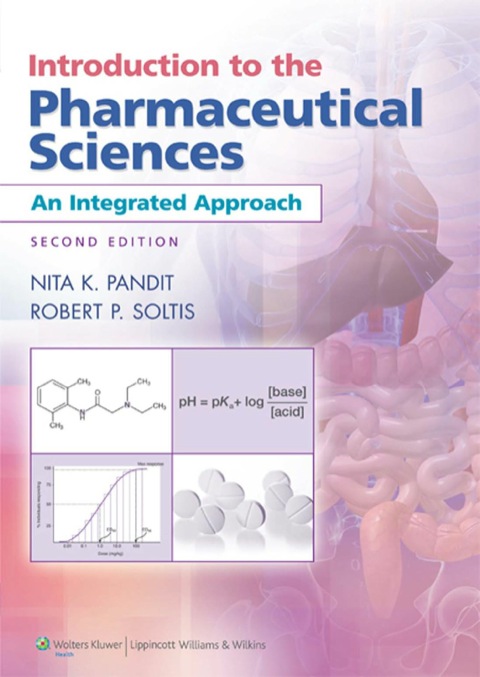Description
Efnisyfirlit
- Introduction to the Pharmaceutical Sciences: An Integrated Approach, Second Edition
- Copyright
- Preface
- Acknowledgments
- Contents
- Additional Resources
- Chapter 1: Introduction
- What Is a Drug?
- How Do Drugs Work?
- How Are Drugs Designed?
- How Are Drugs Administered?
- How Are Drugs Transported in the Body?
- How Are Drugs Used Clinically in Patients?
- How Do Genetic Factors Affect Drug Therapy?
- How Are New Drugs Developed and Approved for Marketing?
- Concluding Remarks
- Part I: Drug Chemistry
- Chapter 2: Drugs and Their Targets
- Targets and Biological Activity
- Binding to the Target
- Physicochemical Properties of Drugs
- Structure–Activity Relationships
- Key Concepts
- Review Questions
- Practice Problems
- Additional Readings
- Chapter 3: Ionization of Drugs
- Electrolytes and Nonelectrolytes
- Importance of Ionization of Weak Electrolytes
- Water as a Solvent
- Strong Acids and Bases
- Weak Acids and Bases
- Salts of Weak Acids and Bases
- Ionization and pH
- Ionization in Unbuffered Solutions
- Compounds with Multiple Ionizable Groups
- Key Concepts
- Review Questions
- Practice Problems
- Additional Readings
- Chapter 4: Solubility and Lipophilicity
- Solubility Principles
- The Solvent
- Water Solubility
- Lipophilicity
- Amphiphilicity
- Key Concepts
- Review Questions
- Practice Problems
- Additional Readings
- Part II: Drug Delivery
- Chapter 5: Transport Across Biological Barriers
- Transport Across the Cell Membrane
- Transport Across a Tissue
- Multiple Transport Pathways
- Key Concepts
- Review Questions
- Additional Readings
- Chapter 6: Drug Absorption
- Systemic Administration
- Systemic Absorption of Macromolecular Drugs
- Local Administration
- Key Concepts
- Review Questions
- Additional Readings
- Chapter 7: Drug Delivery Systems
- Dosage Forms
- Drug Release and Dissolution
- Approaches to Drug Delivery
- Drug Stability
- Delivery of Macromolecular Drugs
- Key Concepts
- Review Questions
- Additional Readings
- Part III: Drug Disposition
- Chapter 8: Drug Distribution
- The Circulatory System
- Drug Distribution Processes
- Volume of Distribution
- Key Concepts
- Review Questions
- Practice Problems
- Additional Readings
- Chapter 9: Drug Excretion
- Excretion by the Kidneys
- Excretion by the Liver
- Excretion by Other Organs
- Key Concepts
- Review Questions
- Practice Problems
- Additional Readings
- Chapter 10: Drug Metabolism
- Excretion or Metabolism?
- Drugs, Metabolites, and Enzymes
- Kinetics of Drug Metabolism
- Types of Drug Metabolism Reactions
- Sites of Metabolism
- Total Body Clearance
- Factors Altering Drug Metabolism
- Key Concepts
- Review Questions
- Practice Problems
- Additional Readings
- Chapter 11: Pharmacokinetic Concepts
- Pharmacokinetics and Pharmacodynamics
- Drug Concentrations in Body Fluids
- Plasma Level Curves
- Pharmacokinetic Features of a Plasma Level Curve
- Relationship Between Pharmacokinetics and Pharmacodynamics
- Pharmacological Features of a Plasma Level Curve
- Multiple Dosing
- Key Concepts
- Review Questions
- Practice Problems
- Additional Readings
- Part IV: Drug Action
- Chapter 12: Ligands and Receptors
- The Signaling Process
- Endogenous Ligands
- Specificity of Actions
- Receptors
- Receptor Structure and Classification
- Modulation of Ligand–Receptor Interactions
- Key Concepts
- Review Questions
- Additional Readings
- Chapter 13: Mechanisms of Drug Action
- Theory of Drug Action
- Quantitation of Drug–Receptor Interactions
- Mechanisms of Antagonism
- Stereoselectivity in Drug Action
- Interaction of Drugs with Enzymes
- Nonreceptor-Based Drug Action
- Key Concepts
- Review Questions
- Additional Readings
- Chapter 14: Dose–Response Relationships
- Concentration–Response Relationships
- Dose–Response Relationships
- Dose-Related Selectivity and Toxicity
- Key Concepts
- Review Questions
- Additional Readings
- Part V: Drug Therapy
- Chapter 15: Therapeutic Variability
- Types of Therapeutic Variability
- Drug Compliance
- Individualization of Therapy
- Key Concepts
- Review Questions
- Additional Readings
- Chapter 16: Drug Interactions
- Drug–Drug Interactions
- Food–Drug Interactions
- Drug–Herbal Interactions
- Dealing with Interactions
- Key Concepts
- Review Questions
- Additional Readings
- Chapter 17: Pharmacogenomics
- Review of Genetics
- Genetic Variation and Disease
- Genetic Variation and Response to Drugs
- Clinical Applications of Pharmacogenomics
- Proteomics
- Promise of Pharmacogenomics
- Key Concepts
- Review Questions
- Additional Readings
- Part VI: Special Topics
- Chapter 18: Biopharmaceutical Drugs
- Biotechnology and Genetic Engineering
- Advantages of the Biopharmaceutical Approach
- Types of Biopharmaceutical Drugs
- Formulation of Biopharmaceutical Drugs
- Stability of Biopharmaceutical Products
- ADME of Biopharmaceutical Drugs
- Pharmacological Considerations of Biopharmaceutical Drugs
- Opportunities and Limitations of Biopharmaceuticals
- Nucleic Acid-Based Therapeutics
- Gene Therapy
- Key Concepts
- Review Questions
- Additional Readings
- Chapter 19: Drug Discovery and Approval
- The FDA
- New Drug Development
- Generic Drug Development and Approval
- Pharmacogenomics in Drug Development
- Over-the-Counter Drugs
- Key Concepts
- Review Questions
- Additional Readings
- Index






